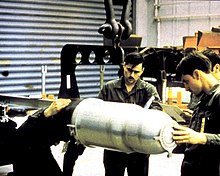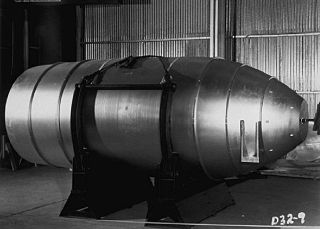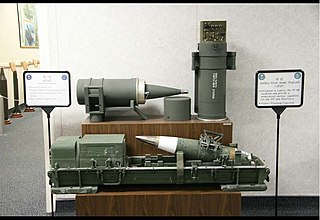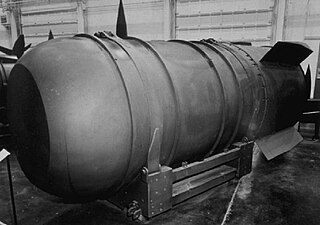
Chuck Hansen (May 13, 1947 - March 26, 2003) was the compiler, over a period of 30 years, of the world's largest private collection of unclassified documents on how America developed atomic and thermonuclear weapons.

Chuck Hansen (May 13, 1947 - March 26, 2003) was the compiler, over a period of 30 years, of the world's largest private collection of unclassified documents on how America developed atomic and thermonuclear weapons.
Hansen's documents were obtained through the U.S. Freedom of Information Act and since his death have been housed at the National Security Archive at George Washington University. [1] [2]
In 1988, Hansen wrote the book U.S. Nuclear Weapons: The Secret History, [3] which, along with great detail about the process of developing, testing and administering atomic weapons was critical of the U.S. Defense Department, the Atomic Energy Commission, and some other government agencies. In the book Hansen reported that the early years of nuclear testing were less successful than claimed; bombs failed, or yielded smaller or larger explosions than anticipated or announced, and attempts to develop a radioactivity-free bomb were unsuccessful. [1] [2] U.S. Nuclear Weapons: The Secret History is currently out of print, but it is available on compact disk through his publisher.
A second compilation of Hansen's material was published on compact disc as Swords of Armageddon in 1995. While Hansen´s U.S. Nuclear Weapons: The Secret History was very instructive, Swords of Armageddon contains much more information and details about nuclear weapons developed by United States. It is in its second revision. [4]

Operation Upshot–Knothole was a series of eleven nuclear test shots conducted in 1953 at the Nevada Test Site. It followed Operation Ivy and preceded Operation Castle.

Ivy King was the largest pure-fission nuclear bomb ever tested by the United States. The bomb was tested during the Truman administration as part of Operation Ivy. This series of tests involved the development of very powerful nuclear weapons in response to the nuclear weapons program of the Soviet Union.
The B46 nuclear bomb was an American high-yield thermonuclear bomb which was designed and tested in the late 1950s. It was never deployed. Though originally intended to be a production design, the B46 ended up being only an intermediate prototype of the B-53 and was test fired several times. These prototypes were known as TX-46 units (Test/Experimental).
The Tsetse was a small American nuclear bomb developed in the 1950s that was used as the primary in several US thermonuclear bombs and as a small stand-alone weapon of its own.

The Mark 14 nuclear bomb was a 1950s strategic thermonuclear weapon, the first deployed solid-fuel hydrogen bomb. It was an experimental design, and only five units were produced in early 1954. It was tested in April 1954 during the Castle Union nuclear test and had a yield of 6.9 Mt. The bomb is often listed as the TX-14 or EC-14. It has also been referred to as the "Alarm Clock" device though it has nothing to do with the design by the same name proposed earlier by Edward Teller and known as the Sloika in the Soviet Union.
The Mark 16 nuclear bomb was a large thermonuclear bomb, based on the design of the Ivy Mike, the first thermonuclear device ever test fired. The Mark 16 is more properly designated TX-16/EC-16 as it only existed in Experimental/Emergency Capability (EC) versions.
RACER IV was a component of some of the first hydrogen bombs made by the United States during the 1950s. The RACER was developed in 1953 at Los Alamos National Laboratory.
The Mark 22 nuclear bomb (Mk-22) was the first thermonuclear device test by the University of California Radiation Lab (UCRL). The test was part of the Koon shot of Operation Castle. The Mk-22 failed to achieve anything like its intended yield due to premature heating of the secondary from exposure to neutrons. As the other UCRL test planned for the Castle series, the liquid-fueled "Ramrod" device had the same basic design flaw, that test was canceled. Within a month of the bomb's failure, the Mk-22 was terminated because the United States Atomic Energy Commission realized there was nothing that could be done to salvage the design.
The Mark 26 nuclear bomb was related to the Mark 21. Development of the Mk-26 started on September 1, 1954. At the end of July 1955, the design of the Mk-21 was released for production, while the design for the Mk-26 was not. The "Clean" Mk-21C which was tested in the Redwing Navajo shot did not interest the US Air Force, or AEC. As the decision not to pursue the "clean" Mk-21 closely coincided with the decision to terminate development of the Mk-26 in April 1957, it is possible that Mk-26 was the designation for the clean version of the Mk-21.
The B77 was a nuclear bomb designed in 1974 to match the delivery capabilities of the B-1A bomber. This included the ability to be dropped from supersonic speeds at altitudes of 60,000 feet (18,000 m), or in a laydown delivery at high subsonic speeds at altitudes as low as 100 feet (30 m). Meant to replace the Mk 28 and Mk 43 in the strategic role, the program was cancelled in December 1977 due to rising costs and the cancellation of the bomber it had been designed to serve. Many components of the B77 including its already tested physics package were incorporated in the B83 which was developed in its place.

The W74 warhead, also known as XM517, was an American nuclear artillery shell that was cancelled before production.

The W82 was a low-yield tactical nuclear warhead developed by the United States and designed to be used in a 155 mm artillery shell. It was conceived as a more flexible replacement for the W48, the previous generation of 155 mm nuclear artillery shell. A previous attempt to replace the W48 with the W74 munition was canceled due to cost.

The W42 was an American nuclear fission weapon developed in 1957.
The W63 was the Lawrence Livermore Laboratory's entry into a brief competition between Livermore and Los Alamos to design a warhead for the Army's Lance tactical surface to surface missile.
The Koon shot of Operation Castle was a test of a thermonuclear device designed at the University of California Radiation Laboratory (UCRL), now Lawrence Livermore National Laboratory (LLNL).
The W64 nuclear warhead was the Los Alamos Laboratory's entry into a brief competition between Lawrence Livermore Laboratory and Los Alamos to design an "enhanced-radiation" nuclear warhead for the United States Army's MGM-52 Lance tactical surface-to-surface missile. In July 1964, both Livermore Labs and Los Alamos started developing competing warheads for the Lance. The Los Alamos design, the W64, was canceled in September 1964 in favor of Livermore's W63. In November 1966, the W63 was canceled in favor of the W70, the model that finally entered production.

The Mk 36 was a heavy high-yield nuclear bomb designed in the 1950s. It was a thermonuclear, using a multi-stage fusion secondary system to generate yields up to about 10 megatons TNT equivalent.
Operation Project 56 was a series of 4 nuclear tests conducted by the United States in 1955–1956 at the Nevada Test Site. These tests followed the Operation Wigwam series and preceded the Operation Redwing series.
A tamper is an optional layer of dense material surrounding the fissile material. It is used in nuclear weapon design to reduce the critical mass of a nuclear weapon and to delay the expansion of the reacting material through its inertia. Due to its inertia it delays the thermal expansion of the fissioning fuel mass, keeping it supercritical longer. Often the same layer serves both as tamper and as neutron reflector. The weapon disintegrates as the reaction proceeds and this stops the reaction, so the use of a tamper makes for a longer-lasting, more energetic and more efficient explosion. The yield can be further enhanced using a fissionable tamper.
The Starling was a small American nuclear bomb developed in the 1950s that was used as the primary in several US thermonuclear weapons.